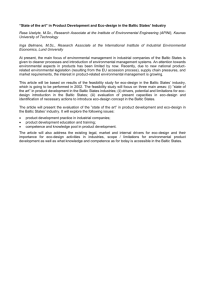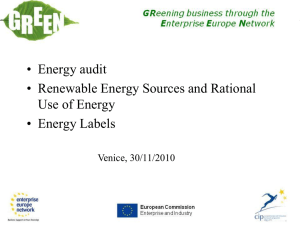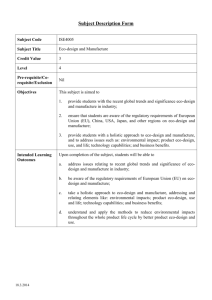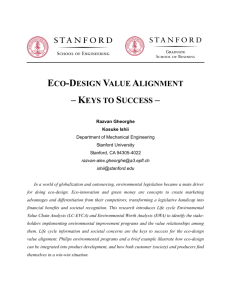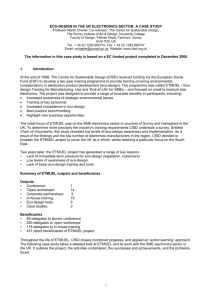ErP-How to comply-May13
advertisement
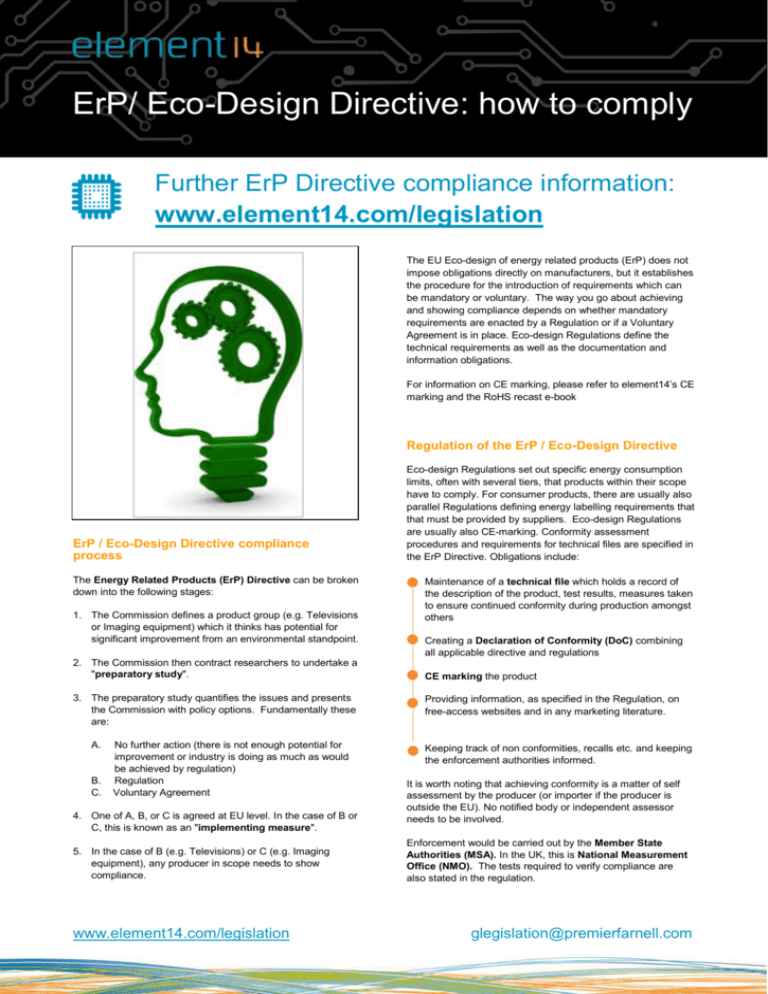
ErP/ Eco-Design Directive: how to comply Further ErP Directive compliance information: www.element14.com/legislation The EU Eco-design of energy related products (ErP) does not impose obligations directly on manufacturers, but it establishes the procedure for the introduction of requirements which can be mandatory or voluntary. The way you go about achieving and showing compliance depends on whether mandatory requirements are enacted by a Regulation or if a Voluntary Agreement is in place. Eco-design Regulations define the technical requirements as well as the documentation and information obligations. For information on CE marking, please refer to element14’s CE marking and the RoHS recast e-book Regulation of the ErP / Eco-Design Directive ErP / Eco-Design Directive compliance process The Energy Related Products (ErP) Directive can be broken down into the following stages: 1. The Commission defines a product group (e.g. Televisions or Imaging equipment) which it thinks has potential for significant improvement from an environmental standpoint. 2. The Commission then contract researchers to undertake a "preparatory study". 3. The preparatory study quantifies the issues and presents the Commission with policy options. Fundamentally these are: A. B. C. No further action (there is not enough potential for improvement or industry is doing as much as would be achieved by regulation) Regulation Voluntary Agreement 4. One of A, B, or C is agreed at EU level. In the case of B or C, this is known as an "implementing measure". 5. In the case of B (e.g. Televisions) or C (e.g. Imaging equipment), any producer in scope needs to show compliance. www.element14.com/legislation Eco-design Regulations set out specific energy consumption limits, often with several tiers, that products within their scope have to comply. For consumer products, there are usually also parallel Regulations defining energy labelling requirements that that must be provided by suppliers. Eco-design Regulations are usually also CE-marking. Conformity assessment procedures and requirements for technical files are specified in the ErP Directive. Obligations include: Maintenance of a technical file which holds a record of the description of the product, test results, measures taken to ensure continued conformity during production amongst others Creating a Declaration of Conformity (DoC) combining all applicable directive and regulations CE marking the product Providing information, as specified in the Regulation, on free-access websites and in any marketing literature. Keeping track of non conformities, recalls etc. and keeping the enforcement authorities informed. It is worth noting that achieving conformity is a matter of self assessment by the producer (or importer if the producer is outside the EU). No notified body or independent assessor needs to be involved. Enforcement would be carried out by the Member State Authorities (MSA). In the UK, this is National Measurement Office (NMO). The tests required to verify compliance are also stated in the regulation. glegislation@premierfarnell.com ErP/ Eco-Design Directive: how to comply Voluntary Agreement (VA) within the ErP / Eco-Design Directive Performance of producers versus the agreement is provided by an "Independent Inspector" (the analogue of the MSA). In this case of voluntary agreement, the Commission agrees a specification with industry which it is satisfied will be at least as successful (in terms of meeting policy aims) as regulation. What precisely each producer must do to meet the requirements of the voluntary agreement, will vary depending on the product group concerned. However, typically it would include: The specification will be similar to a regulation in that it will set performance targets, required information to be supplied, how to verify and dates for submission. Industry must open the agreement up to all players and achieve the buy in of most of that industry by sales (>80% normally). Providing statements of performance / information provided versus the specification on an annual basis Anonymous reporting of these results to a board comprising industry (normally a European Union trade association) and the Commission Publication of an annual report on the performance of the voluntary agreement In the case of non-compliance, the Inspector will issue audits / issues of notices of required corrective action Hence, achieving compliance is again a matter of self assessment by the producer. Please note that CE marking would not include eco-design requirements where a voluntary agreement is in place Note also that the Commission has the power to propose regulation where it sees that the aims of the voluntary agreement are not being met. In summary Self assessment does not mean a voluntary agreement self assessment is used both under regulation and voluntary agreements. Please note: The information contained in this guide is of a general nature and is not intended to address the circumstances of any particular individual or entity. Although we endeavour to provide accurate and timely information, there can be no guarantee that such information is accurate as of the date it is received or that it will continue to be accurate in the future. No-one should act on such information without appropriate professional advice after a thorough examination of the particular situation. ©2013 Premier Farnell plc. Permission is granted for reproduction in whole or in part providing Premier Farnell plc is credited. Written in collaboration with ERA Technology Ltd (www.era.co.uk) www.element14.com/legislation glegislation@premierfarnell.com

